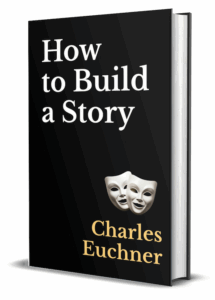

The Essential Guides
How To Build a Story: In our high-tech, hyper-connected, analytic age, storytelling is the essential way to connect with people everywhere. By following 47 intuitive techniques, you will be able to create a compelling tale, with intriguing characters, a revealing storyworld, riveting action and details, and more. Get How To Build a Story in ebook or paperback formats.
The Elements of Writing: The comprehensive system for writing in all fields. Based on the latest research on learning and the brain, The Elements of Writing offers a tactical and practical guide to writing with power (e.g., sentences, words, paragraphs, style, grammar, editing) analyzing complex issues (questions, explaining, models, and more). (Buy The Elements of Writing today in ebook or paperback formats.)
Writing Across the Curriculum
Four Writing Guides Designed for the Classroom . . . And Another Coming Soon
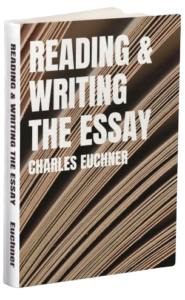 Reading and Writing the Essay: Ideal for rigorous writing classes in high school and college. Reading and Writing the Essay is modeled after William Zinsser’s classic Yale course. Charles Euchner, who taught in that Yale program, offers a complete guide to writing five kinds of essays: profile of a person, description of a place, depiction of action, breakdown of a complex process, and analysis of an issue. (Order Reading and Writing the Essay in ebook format; paperback to be released soon.)
Reading and Writing the Essay: Ideal for rigorous writing classes in high school and college. Reading and Writing the Essay is modeled after William Zinsser’s classic Yale course. Charles Euchner, who taught in that Yale program, offers a complete guide to writing five kinds of essays: profile of a person, description of a place, depiction of action, breakdown of a complex process, and analysis of an issue. (Order Reading and Writing the Essay in ebook format; paperback to be released soon.)
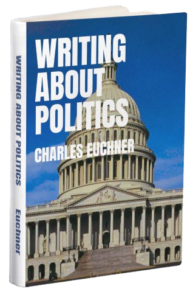 Writing About Politics and Society: Ideal for classes in political science. WAPS uses some of the great modern works on politics and social science–from classic works by John Stuart Mill and George Orwell, literary classics from Shakespeare to Robert Penn Warren, and modern works from Robert Caro, Jane Jacobs, Joan Didion, Yuval Noah Harari, Kim Wehle, and Jennifer Mercieca–to reverse-engineer all 79 elements of writing. By exploring key concepts in politics, we also drill master the essential skills of writing well.
Writing About Politics and Society: Ideal for classes in political science. WAPS uses some of the great modern works on politics and social science–from classic works by John Stuart Mill and George Orwell, literary classics from Shakespeare to Robert Penn Warren, and modern works from Robert Caro, Jane Jacobs, Joan Didion, Yuval Noah Harari, Kim Wehle, and Jennifer Mercieca–to reverse-engineer all 79 elements of writing. By exploring key concepts in politics, we also drill master the essential skills of writing well.
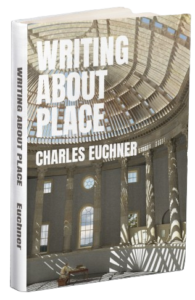 Writing About Place: Designed for students and practitioners in architecture, planning, preservation, and environmental studies … and anyone who cares about place. Based on the acclaimed The Elements of Writing, this new work not only shows the simple, intuitive techniques you need to write well, write fast, right away. It also offers a bevy of case studies from architecture and planning. So to master writing, you also get a dynamic sampling of some of the most important authors and ideas in architecture and planning. (Order Writing About Place in ebook and paperback formats.)
Writing About Place: Designed for students and practitioners in architecture, planning, preservation, and environmental studies … and anyone who cares about place. Based on the acclaimed The Elements of Writing, this new work not only shows the simple, intuitive techniques you need to write well, write fast, right away. It also offers a bevy of case studies from architecture and planning. So to master writing, you also get a dynamic sampling of some of the most important authors and ideas in architecture and planning. (Order Writing About Place in ebook and paperback formats.)
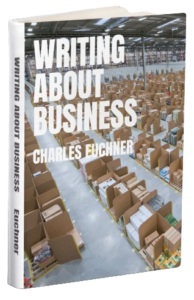 Writing About Business: No matter your profession, communication can make or break your business. Without clear, direct writing, you put yourself at a disadvantage. You risk messing up a contract or orders, misaligning the production process, or failing to connect with customers. Writing About Business explains 79 essential skills for connecting with other people. Each one is simple and intuitive. With case studies for every skill, you can model how the best business writers connect with internal and external audiences.
Writing About Business: No matter your profession, communication can make or break your business. Without clear, direct writing, you put yourself at a disadvantage. You risk messing up a contract or orders, misaligning the production process, or failing to connect with customers. Writing About Business explains 79 essential skills for connecting with other people. Each one is simple and intuitive. With case studies for every skill, you can model how the best business writers connect with internal and external audiences.
Special Topics
What’s Wrong With Business Writing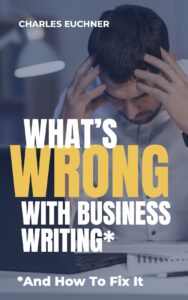 : One skill has the potential to transform businesses in all industries. That skill is writing. Better writing could improve efficiency, creativity, and teamwork at all levels. So why is business writing so bad? To write well requires three things, usually lacking in the professions: (1) A complete system for writing, with simple, intuitive skills based on how the brain works; (2) A process for using that system at all levels of the organization; and (3) a culture of writing, which informs people’s work on a wide range of projects. (Buy What’s Wrong With Business Writing … And How To Fix It now.)
: One skill has the potential to transform businesses in all industries. That skill is writing. Better writing could improve efficiency, creativity, and teamwork at all levels. So why is business writing so bad? To write well requires three things, usually lacking in the professions: (1) A complete system for writing, with simple, intuitive skills based on how the brain works; (2) A process for using that system at all levels of the organization; and (3) a culture of writing, which informs people’s work on a wide range of projects. (Buy What’s Wrong With Business Writing … And How To Fix It now.)
 How to Write a High Impact Book: Everyone seems to be writing a book these days. With the rise of Kindle, iPad, and other electronic readers — not to mention the growth of do-it-yourself publishing — we are experiencing a great Writing Revolution. Most people with brains and diligence can write a book. But too many first-time authors waste hundreds of hours of time. Following a number of simple tricks can help to flatten the learning curve for books and other major writing projects. Plus get this bonus: This NaNoWriMo edition contains a day-by-day strategy for you to complete a complete draft of a novel — or other narrative work — in just 30 days. (Buy How to Write a High-Impact Book now.)
How to Write a High Impact Book: Everyone seems to be writing a book these days. With the rise of Kindle, iPad, and other electronic readers — not to mention the growth of do-it-yourself publishing — we are experiencing a great Writing Revolution. Most people with brains and diligence can write a book. But too many first-time authors waste hundreds of hours of time. Following a number of simple tricks can help to flatten the learning curve for books and other major writing projects. Plus get this bonus: This NaNoWriMo edition contains a day-by-day strategy for you to complete a complete draft of a novel — or other narrative work — in just 30 days. (Buy How to Write a High-Impact Book now.)
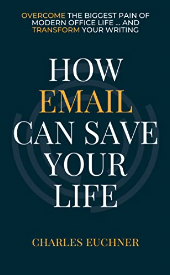 How Email Can Save Your Life: Ridiculous claim, right? But think of it this way: If you can master the art of the short note — offering the news, updates, analyses, and explainers that other professionals need — you will connect better with colleagues, clients, prospects, and more. You will also master all of the key challenges of writing. By focusing on emails, you can burn the essential skills of writing in to your brain.
How Email Can Save Your Life: Ridiculous claim, right? But think of it this way: If you can master the art of the short note — offering the news, updates, analyses, and explainers that other professionals need — you will connect better with colleagues, clients, prospects, and more. You will also master all of the key challenges of writing. By focusing on emails, you can burn the essential skills of writing in to your brain.
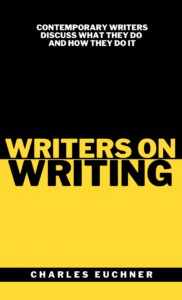 Writers on Writing: What if you could pick the brains of some of the most accomplished writers of our time? Who would you ask about their special tips and hacks? Pulitzer Prize-winning biographer Robert Caro? Memoirist and newspaper writer Katie Hafner? Howard Bryant, today’s best sportswriter? This book offers the powerful insights about the art, science, and craft of writing with more than two dozen of the best practitioners of our time. In these pages, Charles Euchner explores the ins and outs of writing with these and other masters. In these interviews and reviews, you get a lifetime of tips and hacks from some of the best in the business–a page-turning masterclass on how to write with clarity and verve.
Writers on Writing: What if you could pick the brains of some of the most accomplished writers of our time? Who would you ask about their special tips and hacks? Pulitzer Prize-winning biographer Robert Caro? Memoirist and newspaper writer Katie Hafner? Howard Bryant, today’s best sportswriter? This book offers the powerful insights about the art, science, and craft of writing with more than two dozen of the best practitioners of our time. In these pages, Charles Euchner explores the ins and outs of writing with these and other masters. In these interviews and reviews, you get a lifetime of tips and hacks from some of the best in the business–a page-turning masterclass on how to write with clarity and verve.
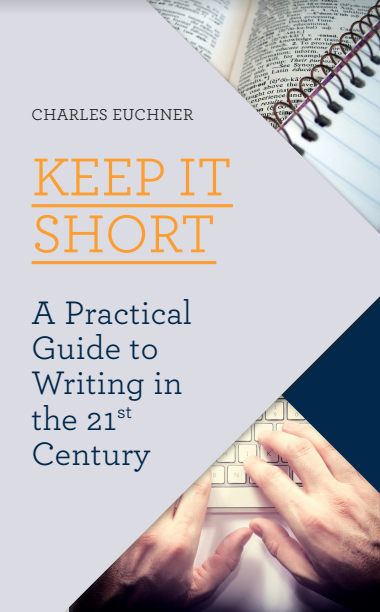
Keep It Short: “Words, words, words,” Hamlet said when Polonius asked what he was reading. These days, Hamlet would say, “Words, words, words, words, words…” This brief guide shows you how to write sharp, engaging prose. Bernard Holland, the longtime music critic of The New York Times, raves: “I wrote short for 30 years because I was a journalist and critic for a newspaper, notoriously stingy with column inches. Keep It Short would have been really helpful. Instead, I learned it all on the job. Take it from me, reading this before you start is easier.” (Buy Keep It Short now.)
In Cold Type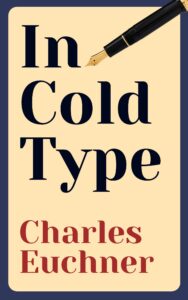 : When Truman Capote published In Cold Blood in 1965, he created the most powerful true-crime story of our times and helped to invent the new genre of the “nonfiction novel.” This tale of the grisly murders of a Kansas farm family rises to the level of literature because of Capote’s mastery of technique. Charles Euchner’s In Cold Type shows how Capote deployed these techniques–and how you can too. (Buy In Cold Type now.)
: When Truman Capote published In Cold Blood in 1965, he created the most powerful true-crime story of our times and helped to invent the new genre of the “nonfiction novel.” This tale of the grisly murders of a Kansas farm family rises to the level of literature because of Capote’s mastery of technique. Charles Euchner’s In Cold Type shows how Capote deployed these techniques–and how you can too. (Buy In Cold Type now.)
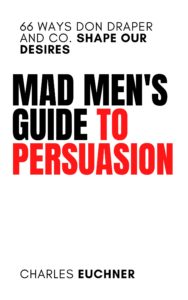 Mad Men’s Guide to Persuasion: Television’s most intelligent series not only offers a powerful drama, but also insights into the art and science of persuasion. This book uses 60 scenes from the Emmy Award-winning program to break down all the essential strategies of persuasion. By using cutting-edge research on the brain, behavioral economics, linguistics, Mad Men’s Guide to Persuasion shows you how to “read” the rhetoric of all media–and how to devise your own strategy of persuasion. (Buy Mad Men’s Guide to Persuasion now.)
Mad Men’s Guide to Persuasion: Television’s most intelligent series not only offers a powerful drama, but also insights into the art and science of persuasion. This book uses 60 scenes from the Emmy Award-winning program to break down all the essential strategies of persuasion. By using cutting-edge research on the brain, behavioral economics, linguistics, Mad Men’s Guide to Persuasion shows you how to “read” the rhetoric of all media–and how to devise your own strategy of persuasion. (Buy Mad Men’s Guide to Persuasion now.)
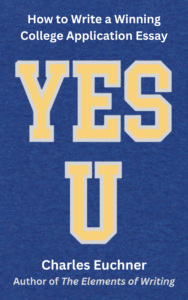 Yes U: The college admissions process has become a scandal. Parents pay thousands of dollars for “coaches” for their kids to get into elite schools — and focus on the elite schools at the cost of the right school. In this brief guide, Charles Euchner shows how to use the college essay as a process to discover the right school–and then how to express that to the admissions committee.
Yes U: The college admissions process has become a scandal. Parents pay thousands of dollars for “coaches” for their kids to get into elite schools — and focus on the elite schools at the cost of the right school. In this brief guide, Charles Euchner shows how to use the college essay as a process to discover the right school–and then how to express that to the admissions committee.
The Minis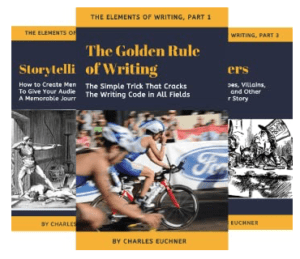
The Golden Rule of Writing: What if you could master every challenge of writing — building great sentences and paragraphs, constructing compelling stories, explaining complex concepts — with one very simple principle? That principle, called The Golden Rule of Writing, states the matter simply: Make everything a journey. Start strong, finish strong. This brief guide shows how to do it. (Buy The Golden Rule of Writing now.)
Storytelling: To connect with any audience, tell a story. You will never meet a person who doesn’t like telling or hearing great stories. Starting with the “narrative arc” that Aristotle outlined 2,500 years ago, give your story a structure that makes the experience whole. Show characters hitting “brick walls,” struggling to achieve some great objective. And create plots that create closure for the hero – and the reader. (Buy Storytelling now.)
Characters: People like watching people. As a storyteller, then, give the reader compelling, surprising, and sympathetic characters. The best character starts with a ”dossier,” a complete inventory of the character’s background, experiences, desires, and values. Show them in action with other types of people. Show how their interactions with other character types reveal their ability to act, learn, and grow. (Buy Characters now.)
World of the Story: The setting not only offers a “container” for the characters and action, but also reflects their values, status, understanding, and struggles. They also help us to know the characters, create possibilities but also impose limits on the characters. Settings help us to explore the larger community and the unfolding action – and to see what’s unusual and deserves attention. (Buy The World of the Story now.)
Action and Scenes: The world, as one philosopher put it, is “one great blooming, buzzing confusion.” To grab and hold the reader’s attention, create action both surprising and meaningful. Get characters to act, knowingly and unknowingly, to move the story forward. Use “beats” to make every moment – every nod, word, and movement – drive the tale. Fill scenes with real human desire and hesitation. And make sure every action somehow reveals something new. (Buy Action and Scenes now.)
Details and Surprise: The best writing surprises. Even when exploring familiar topics, show readers something they don’t already know or feel. Show details that most people would not notice. Approach scenes like a magician. Rather than revealing the obvious, explore the hidden qualities of characters, settings, action, and scenes. Write cinematically, freezing some details and putting others into action. Finally, create scenes of wholeness. (Buy Details and Surprise now.)
The Structure of Writing: “The great book of Nature,” Galileo said, “is written in mathematical language and the characters are triangles, circles, and other geometric figures.” You could say the same about writing. Stories usually take the shape of a narrative arc. But other shapes – lines, circles, and triangles – also offer structure to a piece. To highlight powerful relationships, use numbers – ones to set characters or ideas apart, twos to depict conflict or complements, and threes to reveal dynamism. (Buy The Structure of Writing now.)
Sentences and Paragraphs: The most important unit of writing is the sentence. If you can write “one true sentence,” to use Ernest Hemingway’s term, you can write anything. Good sentences begin with simplicity: strong verbs, clear subjects, and important objects. If the sentence is the most important of unit, the paragraph is the runnerup. Ideally, a paragraph states and develops just one idea. By using “tabloid headlines,” you can make sure that every paragraph stays on point. (Buy Sentences and Paragraphs now)
Words, Words, Words: “The difference between the right word and the almost right word,” Mark Twain once said, “is the difference between lightning and the lightning bug.” To find the right word, start with simplicity. But don’t stop there. Sometimes you need a longer word to write with precision. Active verbs give your writing energy and verve. Avoid adjectives and adverbs. Above all, avoid bureaucratese and academese. (Buy Words, Words, Words now)
Grammar Made Simple: To most writers, grammar is an imposing set of abstract dos and don’ts, with exceptions that bewilder more than enlighten. But grammar is really just a simple way to coordinate your writing. Grammar developed to make life easier, not harder, for writer and reader alike. This ebook offers three simple ways to think about grammar—getting along, traffic management, and being precise. We go into detail, with lots of examples, to show you how grammar enlivens writing—and keep you and your reader on track. (Buy Grammar now)
Editing Without Pain: For most writers, editing poses the most difficult challenge. Faced with an ungainly draft, most writers work methodically from beginning to end. But by moving from the biggest to smallest pieces of your piece, you can edit faster and more effectively. With the “Search and Destroy” system, you can catch more mistakes and avoid “melting down” from overexertion. (Buy Editing Without Pain now)
Writing With Style: Connect with people’s senses of sight, sound, and feeling. As brain researchers now know, you cant know anything until you can feel it too. Metaphors and similes offer an essential approach to helping the reader experience an idea by relating it to something different. Finally, all good style requires a spirit of play to amuse and challenge the reader. You can learn all of these skills, step by step, in this practical guide. (Buy Writing With Style now)
Analysis Without Paralysis: All analysis asks a simple question: What causes what? Once we identify a slew of possible answers to questions, we identify variables. That’s when the real work begins. If we can “operationalize” variables, we can gather factual evidence of possible answers to our questions. we can supplement statistics with testimony from experts. With all these data at hand, we can develop both small-scale and large-scale analysis. (Buy Analysis Without Paralysis now)
Explaining With Stories and Models: All analysis is storytelling at a higher level of abstraction. Stories offer accounts of “one time only” events—particular people doing particular things at particular times, with particular outcomes. Analysis shows recurring patterns of events by looking at large samples of people and things. Models offer a shorthand for analyzing problems in all fields. Most models simplify problems into three variables. You can use these models in both natural and human inquiry. (Buy Explaining With Stories and Models Now)

